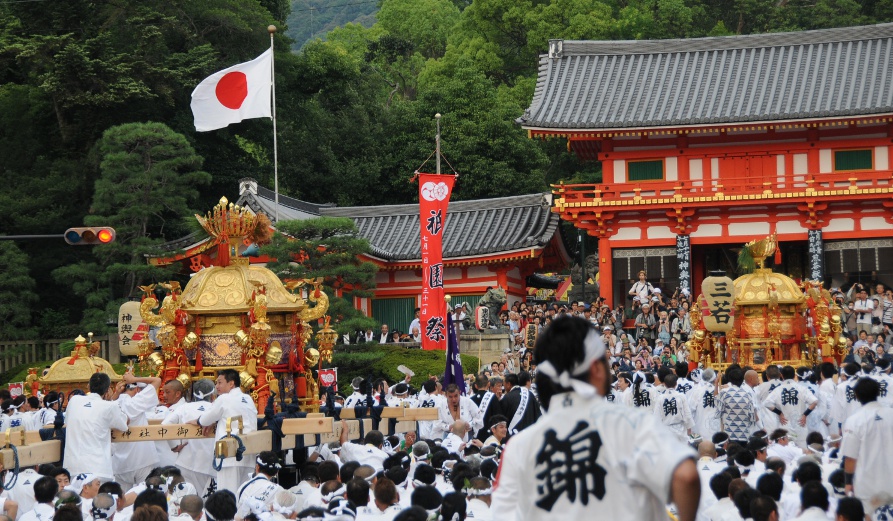Last Wednesday, July 17th, the festivities of Gion matsuri reached their peak. In the morning, there was the Yama Hoko Junko parade through the inner city, and in the early evening the three deities of Yasaka shrine were moved to their temporary residence at the Otabisho.
The procession in the morning was beautiful. In total, there are 32 floats, nine of them called hoko and the others yama. Both types date back to the 17th century or earlier, their wooden base is constructed without any nails or screws, only heavy ropes are used to tie the timber together. They are finally draped with tapestries – replicas of the real ones by now of course – which have been imported from as far off countries as the Netherlands, and thus sometimes depict strangely un-Asian scenes like camels, lions, or the departure of Ulysses from his wife. The originals are exhibited in the respective community houses during yoiyama, from July 14th – 16th and can be visited together with the more or less finished versions of the floats. Constructing a float – even the big hoko – takes only about two days, and this takes place from July 10th – 14th, after the Mikoshi Arai purification rite.
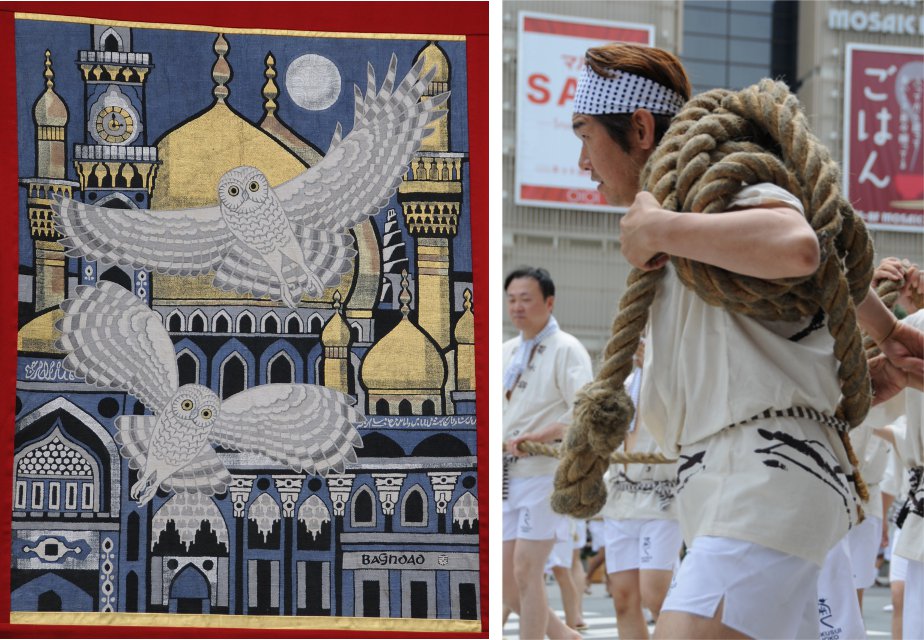
Anyway, back to the two types of floats: A yama is essentially an elevated platform on wheels, maybe four metres high. It is covered with tapestries and shows a well known scene from myth or real history on the platform. The almost life-sized wooden figures used for that are also exhibited during yoiyama, in fact, they are often placed at the centre of an altar and I have seen people placing offers in front of them and praying to them before they are moved onto the platforms. I am not entirely sure, but it seems that the figures used are really the originals, different than the tapestries.
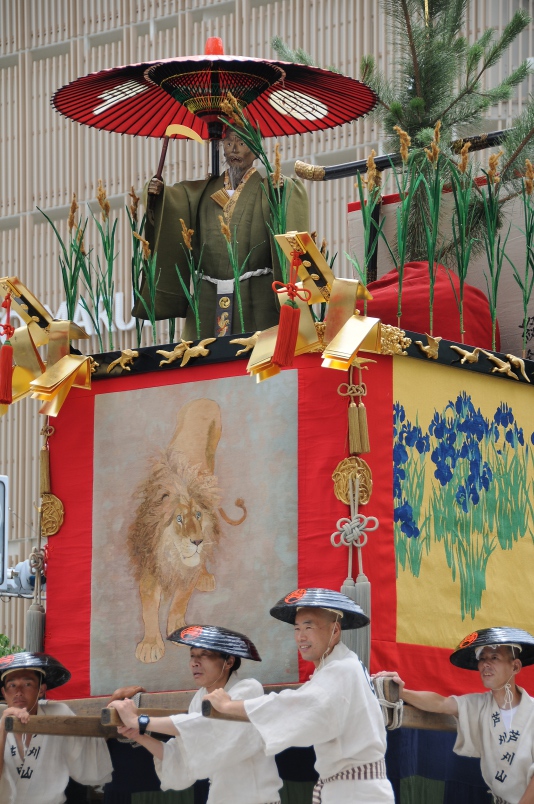
The second type of floats are the hoko. They are enormous things resembling mobile war towers, on man sized wheels, with a roofed platform on which musicians (drums, flutes, bells…) sit and play throughout the procession. On the roof sits a long wooden pole, making the hoko up to 25 metres high in total, and the pole is decorated with straw and paper in the lower part and bears a special type of tip which gives the hoko its name. A hoko can weigh more than ten tons and it is pulled by 40 – 50 men with two thick ropes fastened to the front. Some of the hoko carry wooden images together with the musicians, and all of them are hung with beautiful tapestries.
The procession starts at 9 am, goes along three main streets of the city centre, and has to make three 90 degree turns on the way. I was at the intersection where the first turn would take place at about 8 am, and luckily enough I could still find a spot in the front row – it was surprisingly crowded all the way. Police lined the already empty streets and and many of the shops in this otherwise busy shopping arcade were closed. The people waited patiently, until, as final act before the procession, the overhead traffic lights and signs were folded away. Soon after, you could hear the tune of the musicians, and the very first hoko came down Shijo dori and reached the intersection.
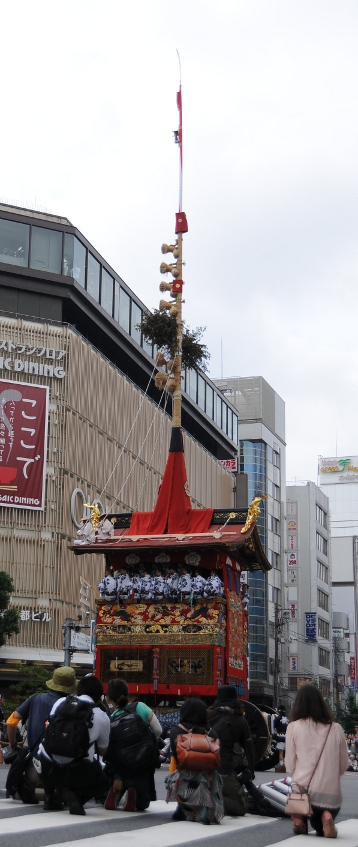
The procession is always headed by the naginata hoko, which has a Japanese halberd, a naginata, on top of its pole. It is the one that has the chigo on board, a child performing rituals from the hoko, to drive evil spirits away. He is chosen among the 10 year old boys of Kyoto’s best families and wears heavy white makeup, golden headgear, and an orange robe with long sleeves.
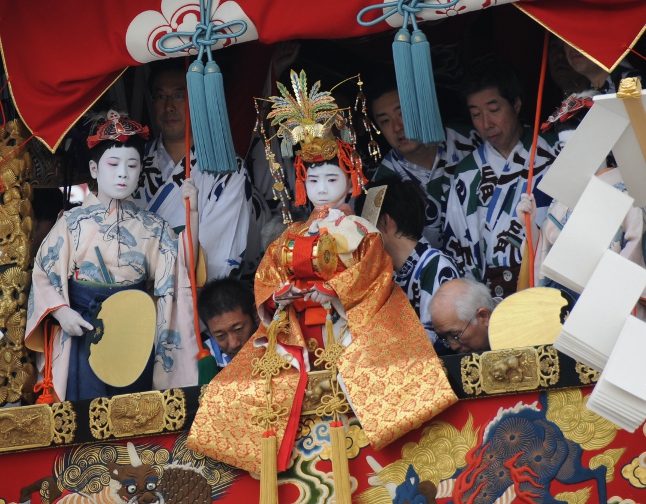
Recall that a hoko is a 10 ton affair pulled by 50 men. They can only go straight and cannot be steered. So, any large change of direction – as the 90 degrees necessary at any of the three curves of the route – is an interesting spectacle. First, the hoko’s front wheels are placed on bamboo poles, slit in half lengthwise, while the back wheels are held in place by large woodblocks. The men standing in the lower part of the hoko, close to the wheels, shout their commands, wave their fans, and then the hoko is pulled to the side in a swift effort. One hoko was turned with only two strong pulls, the others needed more, so the whole operation can take a while. In any case it was very exciting to watch every time, and the musicians on top never ceased to play or even missed a tone.
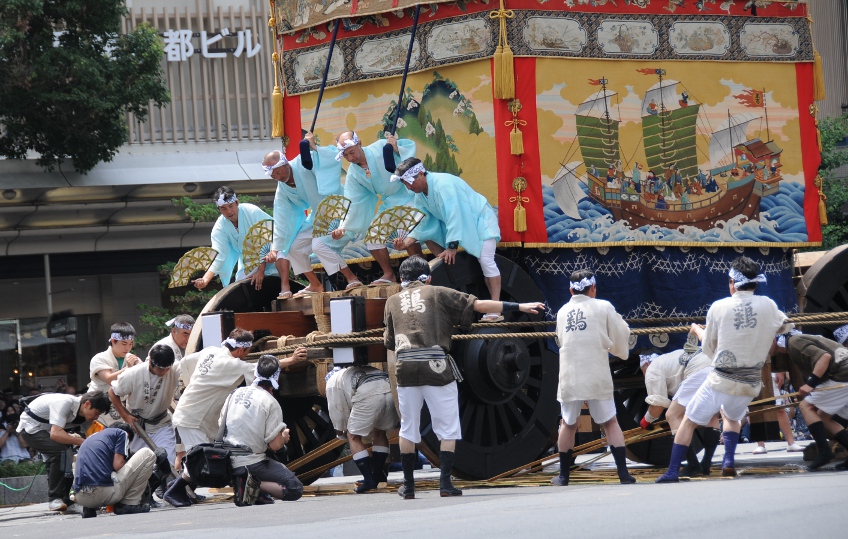
Turning a yama is less of an issue as they can be simply lifted off the ground, although some groups made an effort to show off their strength and made one, even two full turns with the yama – to the great satisfaction of the spectators!
After the naginata hoko come all the others in random order as drawn by lot on July 2nd. The whole procession of all 32 floats takes about three hours to pass any one point. There are many breaks in between though, clearly because of the time the turning of the hoko takes, which cannot be predicted. All in all I found the procession very interesting, but also very tiring, especially as my front row spot meant I had to sit on the hard street with folded knees all the time. I now understand why people bring little folding stools with them – even those who accompany the hoko on foot take a break to sit down during the turning.
In the evening, the second part of the festivities take place. All three mikoshi of Yasaka shrine – and with them their deities – are moved to their temporary residence at the Otabisho, located at the intersection of Shijo and Teramachi. Once again, young men dressed in white carry the mikoshi through the streets of Kyoto to their destination. There are three routes through town, and the atmosphere is light again, with lots of encouraging shouting by the carriers and spectators as well.
